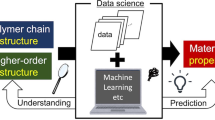Abstract
Purpose. The purpose of this study was to identify the key physicochemical molecular properties of polymeric materials responsible for gaseous diffusion in the polymers.
Methods. Quantitative structure-property relationships, QSPRs were constructed using a genetic algorithm on a training set of 16 polymers for which CO2, N2, O2 diffusion constants were measured. Nine physicochemical properties of each of the polymers were used in the trial basis set for QSPR model construction. The linear cross-correlation matrices were constructed and investigated for colinearity among the members of the training sets. Common water diffusion measures for a limited training set of six polymers was used to construct a 'semi-QSPR' model.
Results. The bulk modulus of the polymer was overwhelmingly found to be the dominant physicochemical polymer property that governs CO2, N2 and O2 diffusion. Some secondary physicochemical properties controlling diffusion, including conformational entropy, were also identified as correlation descriptors. Very significant QSPR diffusion models were constructed for all three gases. Cohesive energy was identified as the main correlation physicochemical property with aqueous diffusion measures.
Conclusions. The dominant role of polymer bulk modulus on gaseous diffusion makes it difficult to develop criteria for selective transport of gases through polymers. Moreover, high bulk moduli are predicted to be necessary for effective gas barrier materials. This property requirement may limit the processing and packaging features of the material. Aqueous diffusion in polymers may occur by a different mechanism than gaseous diffusion since bulk modulus does not correlate with aqueous diffusion, but rather cohesive energy of the polymer.
Similar content being viewed by others
REFERENCES
A. J. Hopfinger and M. G. Koehler. In: Colburn, E.R. ed., Computer Simulation of Polymers, Longman Scientific and Technical, Essex, England, 1994, pp. 1-44.
K. A. Mauritz and R. F. Storey. Macromolecules, 23:2033-2038 (1990).
J. Y. Park and D. R. Paul. J. of Membrane Science, 125:23-39 (1997).
A. Singh and W. J. Koros. Industrial and Engineering-Chemistry-Research, 35:1231-1234 (1996).
M. P. Allen, and D. J. Tildesley. Computer Simulation of Liquids, Clarendon Press, London, Oxford, 1993.
D. G. Doherty and A. J. Hopfinger. Macromolecules, 22:2472-2484 (1989).
B. Jin and A. J. Hopfinger. Pharm. Res., 13:1785-1793 (1996).
J. Bicerano. Prediction of Polymer Properties, Marcel Dekker, Inc., New York, 1993.
J. Crank and G. S. Park. Diffusion in Polymers, Academic Press, London, 1968.
A. J. Hopfinger, M. G. Koehler, R. A, Pearlstein, and S. K. Tripathy. J. Poly. Sci. Part B: Polymer Physics, 26:2007-2028 (1988).
D. W. Van Krevelen. Properties of Polymers-Their Estimation and Correlation with Chemical Structure, Elsevier, Amsterdam, 1990.
D. Rogers. The Proceedings of the Fourth International Conference on Genetic Algorithms. San Diego, 1991, pp. 38-46.
K. A. DeJong. An Analysis of the Behavior of a Class of Genetic Adaptive Systems, University of Michigan Press, Ann Arbor, Michigan, 1975.
J. Holland. Adaptation in Artificial and Natural Systems, University of Michigan Press, Ann Arbor, Michigan, 1975.
J. Friedman. Multivariate Adaptive Regression Splines, Technical Report No. 102. Stanford University, Stanford, California, 1988, revised 1990.
D. Rogers, and A. J. Hopfinger. J. Chem. Inf. Comp. Sci., 34:854-866 (1994).
Author information
Authors and Affiliations
Corresponding author
Rights and permissions
About this article
Cite this article
Patel, H.C., Tokarski, J.S. & Hopfinger, A.J. Molecular Modeling of Polymers 16. Gaseous Diffusion in Polymers: A Quantitative Structure-Property Relationship (QSPR) Analysis. Pharm Res 14, 1349–1354 (1997). https://doi.org/10.1023/A:1012156318612
Issue Date:
DOI: https://doi.org/10.1023/A:1012156318612




